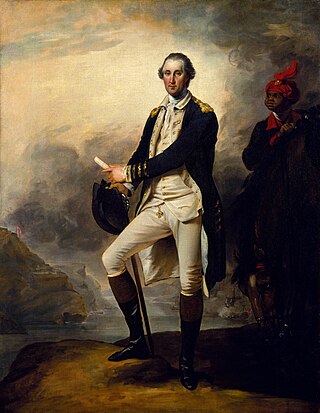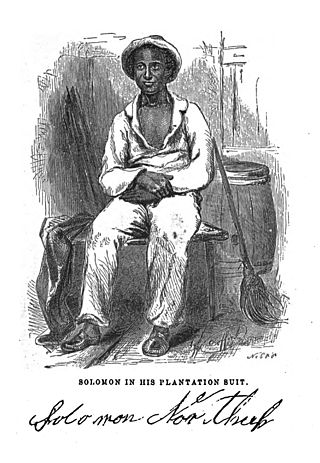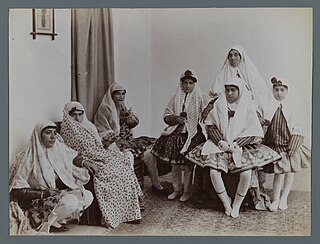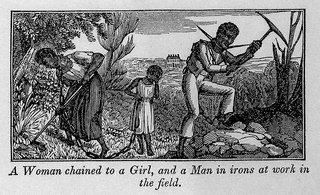
Concubinage is an interpersonal and sexual relationship between two people in which the couple does not want, or cannot, enter into a full marriage. Concubinage and marriage are often regarded as similar, but mutually exclusive.
Slavery in medieval Europe was widespread. Europe and North Africa were part of a highly interconnected trade network across the Mediterranean Sea, and this included slave trading. During the medieval period (500–1500), wartime captives were commonly forced into slavery. As European kingdoms transitioned to feudal societies, a different legal category of unfree persons -- serfdom -- began to replace slavery as the main economic and agricultural engine. Throughout medieval Europe, the perspectives and societal roles of enslaved peoples differed greatly, from some being restricted to agricultural labor to others being positioned as trusted political advisors.

The history of George Washington and slavery reflects Washington's changing attitude toward the ownership of human beings. The preeminent Founding Father of the United States and a hereditary slaveowner, Washington became increasingly uneasy with it. Slavery was then a longstanding institution dating back over a century in Virginia where he lived; it was also longstanding in other American colonies and in world history. Washington's will immediately freed one of his slaves, and required his remaining 123 slaves to serve his wife and be freed no later than her death, so they ultimately became free one year after his own death.

Wife selling in England was a way of ending an unsatisfactory marriage that probably began in the late 17th century, when divorce was a practical impossibility for all but the very wealthiest. After parading his wife with a halter around her neck, arm, or waist, a husband would publicly auction her to the highest bidder. Wife selling provides the backdrop for Thomas Hardy's 1886 novel The Mayor of Casterbridge, in which the central character sells his wife at the beginning of the story, an act that haunts him for the rest of his life, and ultimately destroys him.

Twelve Years a Slave is an 1853 memoir and slave narrative by Solomon Northup as told to and written by David Wilson. Northup, a black man who was born free in New York state, details himself being tricked to go to Washington, D.C., where he was kidnapped and sold into slavery in the Deep South. He was in bondage for 12 years in Louisiana before he was able to secretly get information to friends and family in New York, who in turn secured his release with the aid of the state. Northup's account provides extensive details on the slave markets in Washington, D.C., and New Orleans, and describes at length cotton and sugar cultivation and slave treatment on major plantations in Louisiana.
Solomon Bayley was a formerly enslaved African American who is best known for his 1825 autobiography entitled A Narrative of Some Remarkable Incidents in the Life of Solomon Bayley, Formerly a Slave in the State of Delaware, North America. Published in London, it is among the early slave narratives written by enslaved people who gained freedom before the American Civil War and emancipation. Bayley was born into slavery in Delaware. After escaping and being recaptured, he bought his freedom, including his wife and children. He worked as a farmer and at a sawmill. In their later years, he and his wife emigrated in 1827 to the new colony of Liberia, where he worked as a missionary and farmer. His short book about the colony was published in Delaware in 1833.

The history of slavery in Kentucky dates from the earliest permanent European settlements in the state, until the end of the Civil War. In 1830, enslaved African Americans represented 24 percent of Kentucky's population, a share that had declined to 19.5 percent by 1860, on the eve of the Civil War. Most enslaved people were concentrated in the cities of Louisville and Lexington and in the hemp- and tobacco-producing Bluegrass Region and Jackson Purchase. Other enslaved people lived in the Ohio River counties, where they were most often used in skilled trades or as house servants. Relatively few people were held in slavery in the mountainous regions of eastern and southeastern Kentucky; they served primarily as artisans and service workers in towns.

Slavery in Britain existed before the Roman occupation and until the 11th century, when the Norman conquest of England resulted in the gradual merger of the pre-conquest institution of slavery into serfdom, and all slaves were no longer recognised separately in English law or custom. By the middle of the 12th century, the institution of slavery as it had existed prior to the Norman conquest had fully disappeared, but other forms of unfree servitude continued for some centuries.

The Bible contains many references to slavery, which was a common practice in antiquity. Biblical texts outline sources and the legal status of slaves, economic roles of slavery, types of slavery, and debt slavery, which thoroughly explain the institution of slavery in Israel in antiquity. The Bible stipulates the treatment of slaves, especially in the Old Testament. There are also references to slavery in the New Testament.

Voluntary slavery, in theory, is the condition of slavery entered into at a point of voluntary consent. It is distinguished from involuntary slavery where an individual is forced to a period of servitude usually as punishment for a crime.

Wife selling is the practice of a husband selling his wife and may include the sale of a female by a party outside a marriage. Wife selling has had numerous purposes throughout the practice's history; and the term "wife sale" is not defined in all sources relating to the topic.

The treatment of slaves in the United States often included sexual abuse and rape, the denial of education, and punishments like whippings. Families were often split up by the sale of one or more members, usually never to see or hear of each other again.
Child-selling is the practice of selling children, usually by parents, legal guardians, or subsequent custodians, including adoption agencies, orphanages and Mother and Baby Homes. Where the subsequent relationship with the child is essentially non-exploitative, it is usually the case that purpose of child-selling was to permit adoption.

A scramble was a particular form of slave auction that took place during the Atlantic slave trade in the European colonies of the West Indies and the domestic slave trade of the United States. It was called a "scramble" because buyers would run around in an open space all at once to gather as many enslaved people as possible. Another name for a scramble auction is "Grab and go" slave auctions. Slave ship captains would go to great lengths to prepare their captives and set prices for these auctions to make sure they would receive the highest amount of profits possible because it usually did not involve earlier negotiations or bidding.

Slavery in China has taken various forms throughout history. Slavery was nominally abolished in 1910, although the practice continued until at least 1949. The Chinese term for slave (nuli) can also be roughly translated into 'debtor', 'dependent', or 'subject'. Despite a few attempts to ban it, slavery existed continuously throughout pre-modern China, sometimes serving a key role in politics, economics, and historical events. However slaves in China were a very small part of the population due to a large peasant population that mitigated the need for large scale slave labor. The slave population included war prisoners and kidnapped victims or people who had been sold.

Slavery was a widely accepted practice in ancient Greece, as it was in contemporaneous societies. The principal use of slaves was in agriculture, but they were also used in stone quarries or mines, and as domestic servants.

Concubinage in the Muslim world was the practice of Muslim men entering into intimate relationships without marriage, with enslaved women, though in rare, exceptional cases, sometimes with free women. If the concubine gave birth to a child, she attained a higher status known as umm al-walad.
Although Merovingian Francia is not considered a slave society, slaves were, nonetheless, present throughout the entirety of the dynasty and well into the Carolingian period and beyond. In the 7th century, however, the sale and trade of Christians within Frankish borders was abolished by Queen Balthild, herself a former slave.

Marriage of enslaved people in the United States was generally not legal before the American Civil War (1861–1865). Enslaved African Americans were considered chattel legally, and they were denied human or civil rights until the United States abolished slavery with the passage of the Thirteenth Amendment to the United States Constitution. Both state and federal laws denied, or rarely defined, rights for enslaved people.











